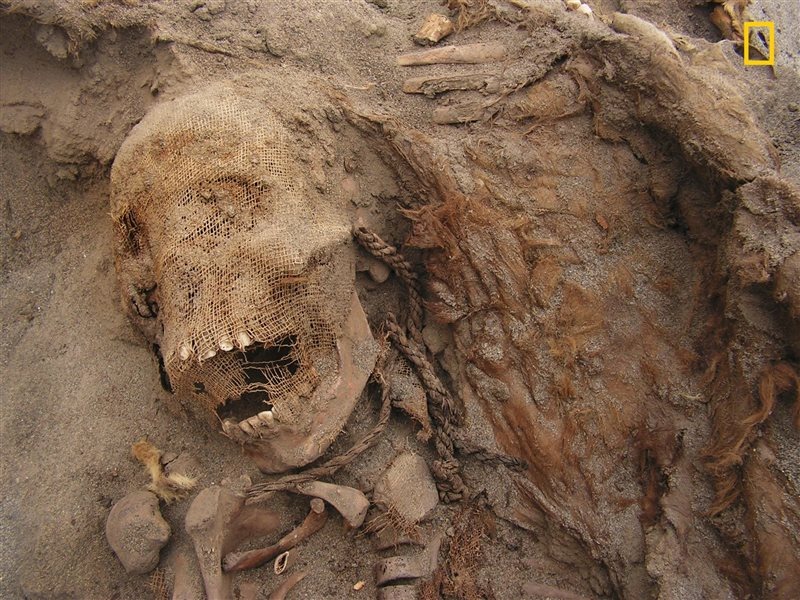Scientific research, funded by the National Geographic Society, has revealed an unprecedented child sacrificial event in the Chimú culture throughout the Americas.
Researchers continue to unravel the events that occurred in Huanchaquito-Las Llamas in order to explain why and how humans called upon supernatural powers in an attempt to control the unpredictable natural world.
Faces painted with a red cinnabar pigment, open mouths that still seem to howl in pain, remnants of the textiles that oppressed their tiny bodies, dislocated ribs, a sternum severed in half, and numerous skeletons of young llamas.

During the ceremony, the faces of many of the children were smeared with a pigment made primarily of red cinnabar. Their chests were then cut open, probably to extract their hearts. The sacrificial llamas seem to have suffered the same fate.
What happened? That must have been asked by archaeologist Gabriel Prieto, from the National University of Trujillo, when in 2011 he directed an emergency excavation in Huanchaquito-Las Llamas, on the north coast of Peru, and the remains of 42 children and 76 llamas were found. Prieto, a native of Huanchaco, was excavating a 3,500-year-old temple nearby when locals alerted him to human remains eroding near coastal dunes.
Archaeologists have unearthed more than a dozen children in a single day. The ritual victims, preserved in the dry sand for more than 500 years, were mostly between 8 and 12 years old when they died.

In 2016, when the excavations in Las Llamas were completed, the skeletal remains of more than 140 boys and girls and more than 200 llamas had appeared that, in all probability, were sacrificed during a ritual that took place between 1400 and 1450, according to the dating by radiocarbon of the ropes and textiles of the funerary bundles. The dramatic event has been framed in the Chimú culture, in the shadow of Chan Chan, the flourishing capital of the Chimú kingdom, whose ruins are less than a kilometer away. Only the Incas commanded an empire larger than the Chimú in pre-Columbian South America: the superior Inca forces put an end to the Chimú kingdom around the year 1475. Archaeologist Gabriel Prieto, second from left, a National Geographic Explorer, excavates the coastal site, where a ritual event took place more than 500 years ago. Prieto trains local students to be the next generation of scientists documenting the history of Huanchaco.

Scientific investigations of the Las Llamas sacrificial site, financed by the National Geographic Society, are being developed by Gabriel Prieto and John Verano, from Tulane University. There is evidence of human sacrificial events among the Aztecs, Mayans, and Incas thanks to Spanish colonial chronicles and modern scientific excavations, but “the discovery of a large-scale infant sacrificial event in the little-known pre-Columbian Chimú civilization is unprecedented in the world.” America, and maybe not the entire world,” said Kristin Romey, the author of an article on the subject published Thursday, a National Geographic exclusive.

The 140 children sacrificed were between 5 and 14 years old, most between 8 and 12; the llamas were less than 18 months old. In a layer of mud, archaeologists have discovered footprints made by adults with sandals, dogs, barefoot children and young llamas, with skid marks that indicate that the animals resisted. The fateful ritual procession has been reconstructed thanks to the footprints: the group of children and llamas were led to the sacrificial site, a viewpoint overlooking the Pacific, where the children were sacrificed and buried, while the corpses of the llamas were left as is. in the wet mud. The skeletal remains (a sternum severed in half and dislocated ribs) evidence the use of macabre violence: her chests were opened, probably to extract her heart. The remains of three adults, one male and two females, were also found in close proximity and likely played some role in the sacrificial event.

Two victims of a dramatic event: a boy and a young llama. Both were part of a sacrificial mᴀssacre that occurred on the north coast of Peru around the year 1450 and that killed more than 140 children and more than 200 llamas.
Haagen Klaus, an anthropologist at George Mason University, suggests in Romey’s article that the societies that occupied the northern Peruvian coast began to sacrifice children when the sacrifice of adults was not enough to stop the repeated alterations produced by the climatic phenomenon of El Little boy. “People sacrifice what they value most. They may have seen that adult sacrifice was ineffective. The rains continued [flooding the Chimú’s agricultural infrastructure]. There may have been a need to try a new type of sacrificial victim,” says Klaus.





